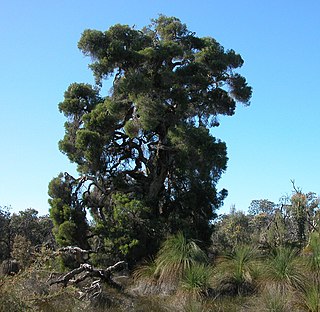
Melaleuca preissiana, commonly known as stout paperbark, modong or moonah, is a plant in the myrtle family, Myrtaceae and is endemic to coastal areas of southwest Australia. It is a shrub or small tree with papery bark, small leaves and spikes of usually white flowers. It occurs chiefly in areas that are seasonally wet.
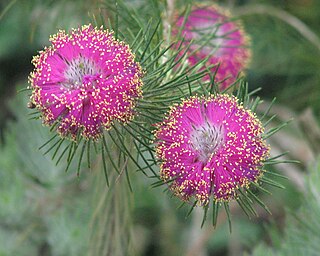
Melaleuca trichophylla is a shrub in the myrtle family, Myrtaceae, endemic to the south-west of Western Australia. Its pink or purple flowers appear from August to December in its native range. It has long been cultivated.

Melaleuca viminea, commonly known as mohan is a plant in the myrtle family Myrtaceae and is endemic to the south-west of Western Australia. It is variable in size and form from a densely branched, small shrub to a small tree. It has become naturalised locally in southern Victoria.

Melaleuca phoenicea, commonly known as scarlet bottlebrush or lesser bottlebrush, is a plant in the myrtle family, Myrtaceae and is endemic to the south-west of Western Australia. The Noongar peoples know the plant as tubada. It is a shrub with thick, blue-green leaves and spikes of scarlet bottlebrush flowers in spring and summer.
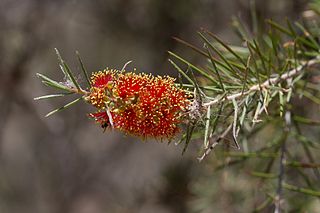
Melaleuca brachyandra, commonly known as prickly bottlebrush or scarlet bottlebrush, is a plant in the myrtle family, Myrtaceae and is endemic to New South Wales, Victoria and South Australia in Australia. It is a shrub or small tree with narrow leaves and showy red and green flowers making it an ideal ornamental plant in temperate areas.
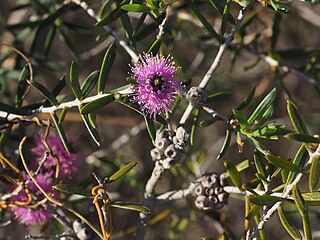
Melaleuca caeca is a plant in the myrtle family, Myrtaceae and is endemic to the south-west of Western Australia. It is similar to a number of other Western Australian melaleucas such as M. pentagona with its purple pom-pom flower heads but it is a smaller shrub with narrower leaves and smaller inflorescences.

Melaleuca leuropoma is a plant in the myrtle family, Myrtaceae and is endemic to the south-west of Western Australia. It is a small to medium-sized shrub which flowers over an extended period with flower colour varying from purple to yellow or white. The glossy, often brown petals covering the flower buds are also an unusual characteristic of this species.

Melaleuca linguiformis is a plant in the myrtle family, Myrtaceae and is endemic to the south of Western Australia. It is a shrub with hairy new growth, small leaves and heads of white flowers similar to Melaleuca teuthidoides shorter sepals and more stamens in each flower.

Melaleuca societatis is a plant in the myrtle family, Myrtaceae and is endemic to the south west of Western Australia. It is a dwarf shrub with small, fleshy leaves and many heads of pink or purple flowers in spring, followed by "soccer-ball" fruit.

Melaleuca stereophloia is a plant in the myrtle family, Myrtaceae and is endemic to the south west of Western Australia. It is similar to the broombush, Melaleuca uncinata with its needle-like leaves and heads of yellow to white flowers, but its bark is hard and fibrous rather than papery.

Conothamnus is a genus of flowering plants in the family Myrtaceae and is endemic to the south-west of Western Australia. They are woody shrubs similar to melaleucas but differ in that their leaves are usually arranged in opposite pairs and the maximum number of seeds per fruit is three.

Melaleuca cardiophylla, commonly known as tangling melaleuca or umbrella bush is a plant in the myrtle family, Myrtaceae and is endemic to the west and south-west of Western Australia. It is a dense, prickly shrub with heart-shaped leaves, stamens that are joined in unusually long claw-like bundles, and distinctive, warty fruits.

Melaleuca ciliosa is a small shrub in the myrtle family, Myrtaceae and is endemic to the south-west of Western Australia. It has bright or pale yellow flowers, an unusual calyx and leaves that are slightly hairy, especially around the edges.

Melaleuca parviceps, commonly known as rough honey-myrtle is a shrub in the myrtle family, Myrtaceae, and is endemic to the south-west of Western Australia. It is a shrub with varying shades of pink or purple flowers, the stamens tipped with yellow anthers. In describing it, John Lindley noted: "every twig ... is terminated by hemispherical heads of brilliant pink". It is similar to Melaleuca manglesii and Melaleuca seriata.
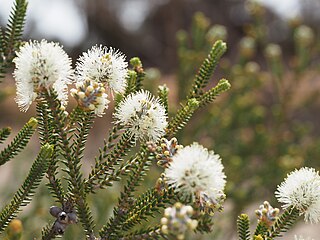
Melaleuca quadrifaria, commonly known as limestone honey-myrtle, is a plant in the myrtle family, Myrtaceae, and is native to the south of Western Australia. It is distinguished by the small size and arrangement of its leaves combined with its small spikes of white or cream flowers.
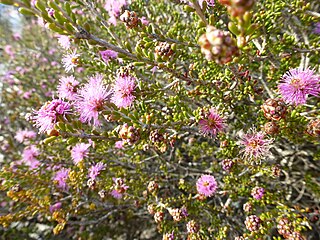
Melaleuca rigidifolia is a shrub in the myrtle family Myrtaceae, endemic to the south of Western Australia. It is similar to Melaleuca plumea with its pink or purple flowers but is distinguished from that species by its lack of fluffy hairs on the flowers and its spherical clusters of fruits.

Melaleuca seriata is a shrub in the myrtle family, Myrtaceae, and is endemic to the south-west of Western Australia. In describing it, John Lindley wrote "Melaleuca seriata, parviceps, and trichophylla, are bushes, every twig of which is terminated by hemispherical heads of a brilliant pink." It is very similar to Melaleuca parviceps.

Melaleuca spathulata is a shrub in the myrtle family, Myrtaceae, and is endemic to the south-west of Western Australia. It is a well known garden shrub featuring dark green leaves against light-coloured foliage, many twisted branches and profuse heads of bright pink "pom pom" flower heads in spring or early summer.

Melaleuca glauca, commonly known as Albany bottlebrush is a plant in the myrtle family, Myrtaceae and is endemic to the south-west of Western Australia. It is a tall shrub with glaucous leaves and spikes of red flowers in spring.

Beaufortia macrostemon, commonly known as Darling Range beaufortia, is a plant in the myrtle family, Myrtaceae and is endemic to the southwest of Western Australia. It is a low shrub with multiple stems, hairy young leaves and three stamens in each stamen bundle.






















